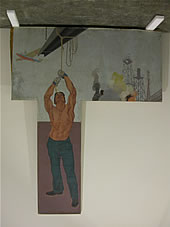 |
Steel Worker panel in 2004 before conservation |
 |
Steel Worker panel after conservation (William Short Photography) |
Forty years after the Santa Monica Public Library Mural by Stanton Macdonald-Wright was dismounted from the walls of the old library on Fifth Street and transferred to the Smithsonian Institution in Washington, D.C., most of the mural panels were shipped back to Southern California to be conserved. These panels joined eight others from the library series that were on view in 2001 at the Los Angeles County Museum of Art as part of the Color, Myth, and Music: Stanton Macdonald-Wright and Synchromism exhibition curated by Will South and organized by the North Carolina Museum of Art. The Smithsonian and the exhibition organizers allowed the Prologue and Moving Picture panels to remain in Los Angeles while a loan agreement was negotiated between the city of Santa Monica and the Smithsonian American Art Museum for return of the mural to the new Main Library that was being designed.
In 2004 the city hired conservators Dr. Duane Chartier and Susanne Friend of ConservArt Associates in Culver City and art historian Dr. Ilene Susan Fort to oversee the mural conservation and installation project. Professional conservators begin by examining the structure and materials used to create a work of art in order to determine how best to preserve it. In July this team traveled to a Maryland storage facility to examine and evaluate more than 30 mural panels. That fall the conservators also examined the panels held over in Los Angeles from the Macdonald-Wright exhibition.
ConservArt’s detailed condition reports of the mural panels revealed new information about the artist’s painting technique and the assembly and original installation of the large mural cycle. Technical assistants hired by the artist through the Public Works of Art Program (PWAP) precisely cut the mural panels from three-fourths inch thick, five-ply plywood that measured 120 inches by 60 inches or 48 inches. Macdonald-Wright used two types of plywood: one with thicker second and fourth plies and the other with a thicker third ply. The same type of plywood was used when pieces were joined to create a panel. Except where panels met at corners of the reading room, the joining edges of panels were doweled to create a seamless narrative flow. A system of horizontal and vertical wood battens glued and screwed into the back of the plywood reinforced the panels. The backs of the panels were coated with a sealing paint that sometimes had a shellac layer on top. Dowel details, accession numbers and penciled inscriptions on the verso of some of the panels provided further documentation of the mural’s original sequence and wall placement.
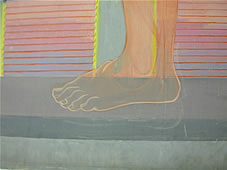 |
| Pentimento of foot in Machine Shop panel
|
The fronts of the panels were prepared by the application of a thin white ground layer that was likely oil. Macdonald-Wright painted the mural with oil paint that he applied thinly and evenly by brush following the plywood grain in a vertical direction. One notable exception was the artist’s use of impasto in his image of the small abstract painting in the style of Morgan Russell which appears in the Edgar Allan Poe panel. This variation in brushwork may have been Macdonald-Wright’s way of paying homage to his friend and fellow Synchromist, whom the artist considered a great modernist. Examination of the mural also revealed pentimenti and the artist’s pencil underdrawings. All of the panels were coated with an early synthetic varnish. Many of the larger panels had corners that were not painted, suggesting that these panels were secured and painted in an upright position before being mounted on the wall. Other panels had no unpainted areas and appear to have been painted in place on the wall.
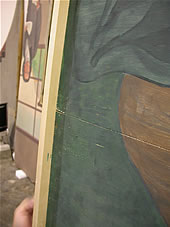 |
Conservators add stabilizing wood pieces to LaPlace & Herschel panel to prevent torquing during transit to California |
In 2005 the California Cultural and Historical Endowment awarded the city a matching grant to conserve and install the mural in the new Main Library then under construction. ConservArt’s condition reports on all of the panels identified damage from environmental, handling, and storage factors. Prior conservation of a few panels – for example, the lunette-shaped Meeting of Caravans panel on view at the Santa Monica Airport in the early 1990’s – were also deemed unsuitable. ConservArt evaluated the overall condition of the panels as “fair” to “good.” Thirty years of display in the old library had resulted in damage to the mural’s painted surface. The old Main Library, which was built in 1904 and expanded and remodeled in 1927, did not have environmental controls for housing artworks. Fortunately, the use of three-fourths inch thick plywood that was coated on both sides mitigated possible damaging effects that relative humidity could have caused in a coastal climate. The mural’s surface, however, was extremely dirty with accumulations of black particulate matter and embedded hand and fingerprints from the public and careless handlers. There were gouges, scratches and abrasions down to the white ground layer on all of the panels. The varnish was streaky, yellowed, or so badly deteriorated that it was not detectable on some panels. Dismounting Macdonald-Wright’s “portable murals” in 1965 caused considerable damage. Several panels showed pry bar marks, were missing sections of plywood, or had broken battens from being forcibly ripped off the wall or from panels being hastily separated from each other.
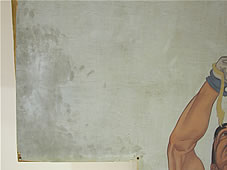 |
Detail showing dirty handprints on Steel Worker panel before conservation |
Conservators perform the minimum treatment necessary and use reversible materials whenever possible in preserving art. ConservArt conducted solubility tests on all of the panels and determined that the paint was stable. The conservation team followed the protocol of structurally repairing the panels, cleaning them, making appropriate repair of paint losses, and varnishing. The conservators initially performed dry cleaning with a hydrophobic sponge. Surface dirt and fingerprints were removed by wet cleaning with saliva or ammonium citrate. The original varnish, or unsuitable varnish applied during previous conservation, was removed taking care not to disturb paint that Macdonald-Wright had applied after the varnishing coat was put on. Battens were repaired in order to stabilize the panels for reinstallation. Delaminated edges were consolidated. Missing and damaged ply was filled with plywood and appropriate putty or filler. Paint losses were filled and inpainting done only as necessary. Finally, the mural was varnished taking care to have an appropriate level of saturation.
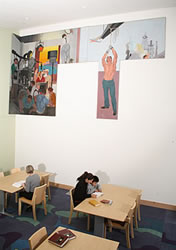 |
Grouping of Steel Worker and Moving Picture panels in the new Main Library (William Short Photography) |
Macdonald-Wright’s wonderfully vibrant palette – his flaming oranges, deep reds, and lively greens – can once again be seen following the library mural’s conservation. The mural’s reordered installation on the second floor of the new Main Library, which opened at 601 Santa Monica Boulevard in 2006, allows the public to see the unique shapes and structural qualities, including exposed dowel details, of this massive 2,000 square foot work of art. Today, appropriate measures are in place to preserve the mural. Many of the new panel groupings hang high on the walls to avoid possible damage. Where panels are hung low, protective glass shields them. Environmental monitoring of the mural is also in place. The mural’s conservation enables the public to enjoy this historical mural in its new context and adds another chapter in its fascinating story.


